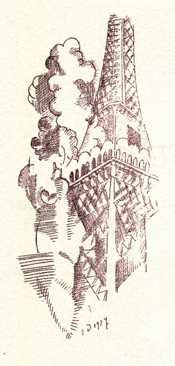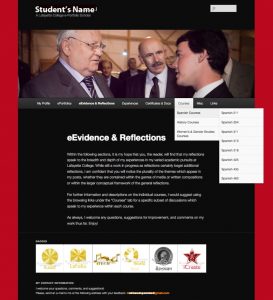Professional Narrative* of Mary Toulouse, Director of the Language & Literatures Resource Center
—Blending Technology with the Teaching of Global Languages
 In this Delaunay illustration of the Eiffel Tower, we see a testament to the power and potential of technology when combined with its muse in the arts; in my view, this icon aptly portrays the dual role and work of the administrator of a modern, global language center. Bilingual and bicultural, trained as both a humanist and an educational technologist, teacher and administrator, I have endeavored to fulfill the charge given me of always trying to find ways to serve the learning community around me: students and colleagues on my campus as well as secondary and post-secondary teachers at the regional level and at the national level. I have held a leadership position and been a regular participate at NEALLT, presented at ACTFL and the AAC&U, and developed hands-on workshops for CALPER as well as other institutions. If I were to change anything in the Delaunay representation, it would be to place the muse before the tower; learning should be inspired by good pedagogy, not technology driven simply for the sake of using technology. See award.
In this Delaunay illustration of the Eiffel Tower, we see a testament to the power and potential of technology when combined with its muse in the arts; in my view, this icon aptly portrays the dual role and work of the administrator of a modern, global language center. Bilingual and bicultural, trained as both a humanist and an educational technologist, teacher and administrator, I have endeavored to fulfill the charge given me of always trying to find ways to serve the learning community around me: students and colleagues on my campus as well as secondary and post-secondary teachers at the regional level and at the national level. I have held a leadership position and been a regular participate at NEALLT, presented at ACTFL and the AAC&U, and developed hands-on workshops for CALPER as well as other institutions. If I were to change anything in the Delaunay representation, it would be to place the muse before the tower; learning should be inspired by good pedagogy, not technology driven simply for the sake of using technology. See award.
One particular initiative stands out in my tenure as Director of the Foreign Language and Literatures Resource Centre at Lafayette College. Since 2007, I have worked closely with colleagues to incorporate national standards and guidelines (ACTFL 5 C’s, IPA’s, and AACU VALUE rubrics) and to develop alternative assessment practices by using digital tools—an electronic portfolio and badge network— as a compliment to traditional testing and evaluations of student achievements. For my part, I have developed the information  architecture, reviewed the software options, and implemented the resulting tools in the elementary language classes I have taught as well as provided pedagogical and technical support to others as they, too, have used portfolios and badges with their students in multiple languages, with varying levels of proficiency, and at different places in their educational journey. This collective and collaborative enterprise has been documented and shared in the 2013 ADFL article, “Electronic Portfolios: A Blueprint for Deep Language Learning and Assessment” and the forthcoming (2017) Springer Encyclopedia of Language and Education entry, “Electronic Portfolios for Language Learning and Assessment”; an additional article Telling Tales Out of School: Digital Badges, e-Portfolios, and the Next Generation of Learners, is in preparation for 2018.
architecture, reviewed the software options, and implemented the resulting tools in the elementary language classes I have taught as well as provided pedagogical and technical support to others as they, too, have used portfolios and badges with their students in multiple languages, with varying levels of proficiency, and at different places in their educational journey. This collective and collaborative enterprise has been documented and shared in the 2013 ADFL article, “Electronic Portfolios: A Blueprint for Deep Language Learning and Assessment” and the forthcoming (2017) Springer Encyclopedia of Language and Education entry, “Electronic Portfolios for Language Learning and Assessment”; an additional article Telling Tales Out of School: Digital Badges, e-Portfolios, and the Next Generation of Learners, is in preparation for 2018.
(C-Connecting Sample 1_1. C-Comparisons Sample 1_2. C-Communities Sample 1_3. C-Cultures Sample 1_4)
We currently have over 1770 portfolios on campus; some students have exported them and continue to build on them after graduation—evidence of a true lifelong learning tool; this is easily facilitated because of the free, open source software, WordPress, which we use to support our portfolios. Upon enrollment in an entry level language class, I provide each student with a template to get them started; they will then continue to build on this same portfolio during their entire educational journey at Lafayette. The template is based on ACTFL national standards and encourages the interdisciplinary, transcurricular development that is so important to making a portfolio “sticky” to use Aljafari’s term. Our badge work has been built using the Mozilla Open Badge platform. Importantly, we are currently participating in a campus-wide workshop initiative to scale up use in other disciplines—this is a success story that started in the Language Department! Multiple examples of student portfolios can be seen in our gallery.
Each student’s e-Portfolio is constructed as an overarching, umbrella type of portfolio. An instructor of French language at the elementary and intermediate levels of the College, I have personally beta-tested and integrated the use of a nested course blog-type portfolio into this umbrella portfolio for my students. In the elementary and intermediate language courses, the focus is on communicative competency and the students are asked to tag evidence (multimedia artifacts) of their proficiency as “I can read”, “I can write”, and “I can speak” as well as provide a short reflection on the challenges and successes of their artifact. The results have been exceptionally positive: the students have repeatedly reported that this organization into the language “modes” is helpful and helps them see progress or focus on areas which they want to improve; students feel more in control and positive about their experience in the class; more students are continuing to the next level and not stopping because the “requirement” has been fulfilled; and lastly, their performance on IPA tests has improved. The portfolio has helped these students develop important metacognitive skills and shows evidence of being an important tool in the learning process, not just an archive where student work is deposited. At the end of this class, students are ready to apply for the i-Lingua badge. View student sample 2_1. View student sample 2_2. See course objectives and outcomes.
Although I have used a variety of technologies over the years in my classes as well as in support of other faculty initiatives, I believe that the portfolio-badge initiative is, as former Obama Education Secretary Arne Duncan said, “a Game-Changing” set of tools for education in the 21st century. With this initiative, we strive to rebalance the discourse from the current over attention to test scores and instruction so as to provide a meaningful focus on student-produced evidence and student agency; in other words, “What the students can do with what they know.” The portfolio and badge are the vehicles for the telling of the student’s story, an important compliment to the GPA score and list of courses in a transcript. Different from a test, the portfolio-badge network is more than an “end” document; it encourages lifelong learning of languages as well as an important reflective component where students are encouraged to think about the trajectory of their learning on their lives. Moreover, the portfolio is an inclusive tool for students whose work and talents may not be validated by traditionally used academic practices. Student sample 3_1. Student sample 3_2. Student sample 3_3.
In conclusion, I note the current and historic grassroots movement for the development of Seals of Biliteracy, mini credentials that are, in fact, similar to the Lafolio badge. The development of seals is a critical opportunity for the promotion of good practices and the study of global languages in the United States. To date, over 26 states have approved some version of a seal, 5 are considering it, and 8 are in the early stages of development; importantly, in most cases, the guidelines are still in the process of being formulated. It is essential that these states have a variety of models and research from which to draw ideas and vet different options in their institutions so as to ultimately realize the full potential of these important new credentials. Fortuitously, in four cases, e.g., NYC, California, Washington, DC, and Oregon, the use of portfolios is already being encouraged and solicited. In fact, I am honored to have been invited to do a workshop on the LaFolio package at the NYCDOE LOTE conference this month (June, 2107). I am confident that the work we have done on LaFolio portfolio-badge network over the last ten years is significant and would also be of interest at the national level, in particular, given the current conjuncture and development of Seals. Thank you for considering this work for the ACTFL –Cengage award.
Please see below for an appendix of detailed documentation in support of this narrative.
Respectfully submitted by Mary Toulouse
Director of the Foreign Languages and Literatures Resource Center, Lafayette College
*Recipient: 2016 The Lafayette College Distinguished Service Award (LCDSA)
Additional Documentation: Please click on the links below.
Nuts & Bolts of LaFolio: Information Architecture and Artifacts
Badges Promote Reflection Through the Combined Use of Portfolios and Badges
Gallery of Student Work: Putting in Practice National Standards (Class and Program Samples)
How I teach: Communicative Competence in the Nested Class Portfolios–Objectives and Outcomes (Elementary and Intermediate French classes-Prof. Mary Toulouse)
What people are saying: letters of support, college query from students feedback, Lafayette news
For general information on the Lafolio portfolio initiative: http://lafolio.lafayette.edu/
For general on the LaFolio Badges: http://lafolio.lafayette.edu/badges/